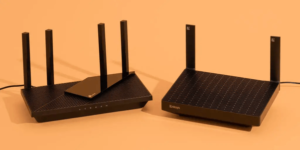When your friend pays you a visit and requests the WiFi password, it might seem like a harmless request. After all, you trust this individual on your network. However, surprisingly, sharing this seemingly innocuous piece of information can lead to a data breach that compromises all the devices connected to the network, unbeknownst to both parties.
To prevent this unintentional security risk, the simplest solution is to establish a guest WiFi network. Creating a distinct access point for guests and vulnerable devices can effectively ward off accidental cyberattacks. This article delves into the concept of a guest network, its significance, and offers a straightforward, five-step manual guide to setting one up.

What Exactly Is a Guest Network?
A guest WiFi network provides an internet connection separate from the one used by your primary devices. The typical WiFi setup connects devices to a single router that grants internet access. By introducing a separate gateway to the internet through guest WiFi, you grant internet access to devices that may be more prone to viruses, all while safeguarding your home network from potential threats.
Is Guest WiFi Secure?
Guest WiFi is the safest way to offer internet access to your visitors while preserving the integrity of your existing network. If your guests connect to your primary network with a compromised or malware-infected device, there’s a risk of the virus spreading to your home devices connected to the same WiFi.
However, if the compromised device connects to the guest WiFi, the virus or malware remains isolated and cannot breach your home network. Additionally, guest WiFi offers an extra layer of protection for IoT devices, such as smart TVs, which are more susceptible to security vulnerabilities.
Should You Set a Password for Guest WiFi?
All WiFi networks should have passwords to prevent unknown devices from connecting. While your primary network should have a strong, complex password, it’s acceptable for guest WiFi to have a simplified password that’s easy to share and change if necessary.
How to Monitor Connected Devices on Your WiFi
You can monitor the devices connected to your WiFi by accessing your router’s web interface. If you suspect unknown devices have gained access to your network, you can remove them via the interface.
If you don’t recognize the devices listed in your router’s web interface, it’s wise to change the WiFi password. This will require all users to enter the new password to regain network access.
How to Establish a Guest WiFi Network?
Creating a guest WiFi network is often as straightforward as adjusting your preferences. Most routers offer options for adding additional networks through the administrator settings. Here are the steps to manually configure your router settings and set up a guest network:
Step 1: Locate your router in your web browser. Find the router’s IP address in the user manual or on the router itself, and input it into your browser’s search bar.
Step 2: Log in to your router with administrator access.
Step 3: Modify the existing network settings. Locate your wireless or router settings and select the option to enable a guest network.
Step 4: Name the network. After enabling guest WiFi, set the network name in the SSID field. Most routers will automatically append “-guest” to the existing network name by default.
Step 5: Configure the guest network settings. Create a new password and select a network security method (WPA or WPA2). Ensure that guests cannot access the primary network and its settings.
By establishing a separate WiFi network for guests and vulnerable smart devices, you add an extra layer of security to your primary network. Often, viruses operate with the primary objective of infecting as many devices as possible, and creating a distinct access point for WiFi is a proactive defense against potential cyberattacks on your network.

